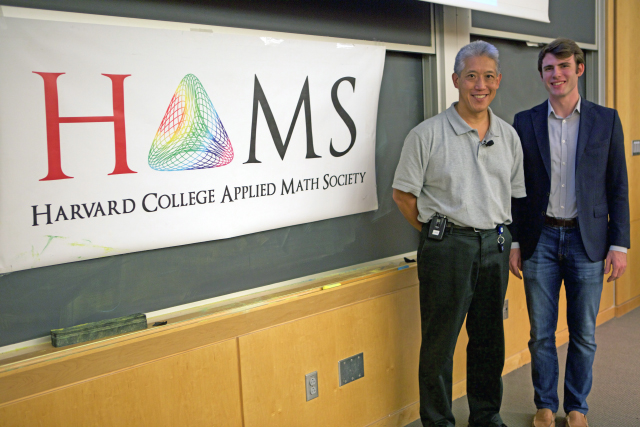Jim Tung, A.B. ’81, shares insights with SEAS students
Technologist Jim Tung, A.B. ’81, recently returned to Harvard to share insights from a career in mathematics with a group of John A. Paulson School of Engineering and Applied Sciences (SEAS) students.
Tung, who has worked at MathWorks since 1988, spoke on Oct. 21 as part of the Harvard Applied Math Society’s (HAMS) speaker series. He discussed the importance of mathematics across applications and industries, and the role he expects math to play in future innovations.
“Technology is changing so rapidly. Learning how to think about technology is going to be a lifelong skill,” Tung said. “Math fluency helps make that possible.”
A deep interest in mathematics was pivotal for Tung’s career, which began in a marketing role at a Boston tech startup. As the psychology and social relations concentrator worked to market the startup’s data acquisition system, he proactively sought out more mathematics knowledge from colleagues and customers.
In 1988 he joined MathWorks, then a small, little-known company, and contributed to the development and promotion of its signature software product, MATLAB. In his current role as MathWorks Fellow, Tung helps define technology strategy and the direction of the firm, which now has more than 3,000 employees and annual revenues of $800 million.
“Having the opportunity to shape a company that creates change in the world makes MathWorks such a fun place to work,” he said. “I love meeting with our customers, because they are doing the most amazing things.”
During his presentation, he gave examples of how MATLAB is enabling engineers, scientists, and academicians to develop cutting-edge products in many different fields, including aerospace, medicine, and renewable energy.
For instance, a modern car has about 100 processors with more than 100 million lines of code, Tung explained. Systems such as anti-lock brakes, cruise control, and automatic door locks are driven by algorithms. Conceiving, developing, and evaluating those algorithms requires a solid understanding of the math behind the scenes, he said.
Tung advised students to think broadly about how math can help them exceed their career expectations.
“In the future, almost every system is going to have some algorithmic content,” Tung said. “Teams that build these products will need to be able to understand those algorithms so they can ensure the devices will behave the way they are designed to. There are a dizzying number of industries and applications students can pursue.”
That message is one HAMS emphasizes to its nearly 400 members. The organization encourages job-seeking students to consider less traditional fields and explore career opportunities at smaller companies, said club president Aron Szanto, A.B. ’18, an applied math, economics, and computer science concentrator.
“Our hope is that, by listening to Mr. Tung speak, students will be inspired to take another risk or reach out to a company they otherwise wouldn’t have considered,” Szanto said. “There are so many ways that math can translate into a rewarding career.”

Alumnus Jim Tung, A.B. '81, with Harvard Applied Math Society President Aron Szanto, A.B. '18. (Photo by Adam Zewe/SEAS Communications.)
Speak at SEAS
Are you interested in sharing your expertise or advice with SEAS students? We are seeking alumni of all backgrounds to speak to student clubs on a number of topics, including industry news and trends, science and technology, entrepreneurship, career advice, and more. Please contact azewe@seas.harvard.edu for more information.